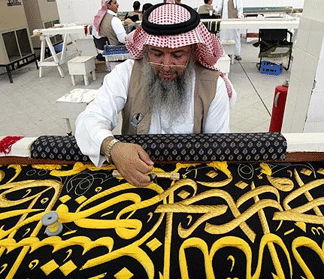
[Note: For a Youtube documentary on the Saudi Kiswah Factory, click here.]
By Manal Homeidan, Asharq Alawsat, December 17, 2007
Jeddah, Asharq Al-Awsat – Following their departure from Mecca, millions of pilgrims have started to make their way to Mount Arafat. Coinciding with this unchanged ritual is the tradition of changing of the Kaaba’s ‘kiswah’, the cloth that adorns the Kaaba made of black silk and embroidered with gold calligraphy.
This event is customarily attended by the gate-keepers of the Kaaba and technicians from the Kiswah Factory, which has been manufacturing the fabric that adorns the Kaaba for the past six decades. These technicians employ a special mobile escalator so as to remove the old cloth and cover it with the new kiswah, one day before the first day of Eid ul-Adha.
Pilgrims visiting the holy Kaaba will see the cloth that has taken a whole year to complete at the hands of highly skilled professional tailors and artisans. The process by which the Kaaba is adorned in the new kiswah entails attaching special metal hooks (47 in total) to the roof of the Kaaba after which the ropes from the old kiswah are cut off so that the new cloth immediately falls above it to cover it. This is to avoid the Kaaba being exposed during the change.
In going with tradition, one-third of the cloth from the bottom is lifted up out of the reach of millions of pilgrims who might want to cut off a piece of the cloth to take with them. There is approximately two meters between the marble floor that surrounds the Kaaba and the beginning of the black kiswah.
Last week, Head of Affairs of the Two Holy Mosques, Sheikh Saleh al Haseen received the new kiswah and fulfilled his role by handing it to the Kaaba’s Senior Custodian, Abdulaziz al Shaibi, who is responsible for ensuring that the fabric is up by 9 Dhul Hijjah (18 December 2007).
The total cost of the Kaaba kiswah is 20 million Saudi Riyals (approximately US $5,365,000, including material and labor); it is made of pure natural black silk and is 14 meters in height. The golden cover belt that encircles the Kaaba is 47 meters long and 95 centimeters wide and is made up of woven golden pieces of Islamic embellishments. Verses of the holy Quran are stitched on the cover with golden and silver wires. A single kiswah consumes approximately 670 kilograms of natural silk and has a total measurement of 658 square meters.
Artisans at the Kiswah Factory are entitled with the embroidery of the belt, lamps and the curtain that drapes over the Kaaba door, in addition to the Quranic verses printed on the black cloth and other embellishments. They employ the necessary techniques, including stitching and padding and use silver- and gold-coated wires. This process consumes approximately 150 kilograms of gold and silver wire.
The ‘burqa’ (veil) that covers the Kaaba door is comprised of a piece of pure black silk that is 6.5 meters long and 3.5 meters wide; it is embellished with Quranic verses and Islamic designs in gold and silver thread. It is the technicians at the Kiswah Factory who are responsible for stitching the pieces that make up the whole gold and silver designs, including the belt and a section that contains a dedication to the Custodian of the Two Holy Mosques, King Abdullah Bin Abdulaziz, with the date in which it was made inscribed upon it.
Four pieces of fabric that are inscribed with Surat al Ikhlas [a Quranic verse] are placed in every corner of the Kaaba, and 11 pieces in the shape of lamps which are inscribed with Quranic verses are also placed in the four corners of the Kaaba.
The final stage is hanging the curtain that covers the door and it is considered one of the most difficult stages in the process of changing the Kaaba’s kiswah. The next step entails lifting the Kaaba cover, which is padded by a thick white cloth that is raised above the marble floor that surrounds the Kaaba.
The old covering with all its related pieces is handed to the Saudi government, which it divides into smaller parts in accordance with particular considerations, and which it then bestows as gifts to senior guests, officials, a number of religious institutions, international institutions and Saudi embassies abroad.
The venerable ancient tradition of re-adorning the Kaaba with the new kiswah on the same Hijri date every year, after it has been washed in rosewater and perfumed in musk and perfumes, has been repeated ever since the establishment of a center that was entitled with making the kiswah in accordance with the orders of King Abdulaziz Bin Abdul Rahman al Saud in 1927. Since then, it has been responsible for that task.
With the passage of time and the progress of the art of weaving and the advancement of technology, the late King Faisal decided to develop the center into a factory that could cope with the Kaaba’s modern needs. In 1972 King Faisal issued a royal decree to expand the center into what has become Mecca’s Kiswah Factory. It was inaugurated under the auspices of the late Custodian of the Two Holy Mosques, King Fahd Bin Abdulaziz on 26 March 1977 during his term as crown prince.